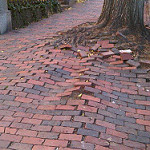by Elizabeth Cogliati

I didn’t used to think about sidewalks much. Not even in college or immediately after, when we walked everywhere because we didn’t have a vehicle. I went to college in a compact, eminently walkable small town, but even so, I believe I logged 4 plus miles every day. Looking back on it, I can’t believe I walked that much. Like I said, I didn’t think about sidewalks much. I just walked on them. Sometimes I climbed over the snowbanks, sometimes I slid on the ice, sometimes I slogged through the mud of the off-sidewalk shortcut, but I didn’t really think about the sidewalks.
When I moved to a bigger town, I had a more difficult time walking because the town’s neighborhoods are not easily connected to the downtown area and are not very walkable. This appears intentional. According to the city ordinances, all new neighborhoods after 1998 must not have straight throughfares directly across them and must have winding roads (older neighborhoods were grandfathered in).
After my baby was born, I discovered that the places I just strolled over by myself were major obstacles with a stroller– canals with no sidewalk along them, major intersections with only stop signs — these things frightened me with my stroller — how could I run across a 4-way stop intersection with 2 lanes in each direction with a stroller? Although I no longer needed to walk (we now had a reliable vehicle), walking was still the only form of transportation for many who did not have access to personal transportation. These sidewalks were vital arteries to the community and to needed resources.
When my baby was almost a year old, we moved into a house in one of the older neighborhoods in our town. It was easier to walk with the stroller– there were blocks and blocks of quiet neighborhood streets without busy intersections. But here I discovered another problem: the sidewalks were in pretty bad shape — large cracks, shifted sections where one section was several inches higher than the neighboring one, holes, and even non-existent sections. I became an expert at lifting the stroller up and over the many obstructions we encountered in our walks.
The more I walked, the more I noticed another problem. I didn’t just have to lift the stroller over frost heaves and root uprisings, I often had to lift it over the curbs at the intersections. There were no curb cuts at many of the intersections (a curb cut is the place where the curb dips down to meet the gutter at a driveway, intersection, or parking area). A proper curb cut usually has a yellow pad with raised dimples to alert blind walkers using a cane that they are approaching an intersection.
About this same time, I began writing opinion pieces for the local newspaper. I decided to write one of my first columns on the sidewalks in the town and their terrible condition. After the column was published, I got a surprise. Individuals in wheelchairs called and wrote to tell me how much they appreciated my column and how badly they needed better sidewalks. For people with different mobility, sidewalks can grant or block access to buildings for both recreation and much-needed resources.
I wrote a couple more columns on sidewalks, attracting more attention each time. After those columns, the city applied for and received a federal grant to improve sidewalk conditions in the business districts of town by adding curb cuts and yellow pads.
My town also has a city government program where the city will pay for homeowners to fix their sidewalks if they cannot afford to do so themselves. When I suggested this program to my neighbor, she told me she couldn’t use the program. Why? Because the program was a reimbursement program. She would have to pay up front to have the sidewalks fixed and then be reimbursed by the city. She did not have the up front money, and there were no alternatives in the city program.
When I watch the people going past my window, I see my neighbors walking their dogs, I see children going back and forth to school, I sometimes see mothers with strollers, I see white men riding bicycles in the street to work – they are usually dressed in professional attire, and I see Latino/a men and women walking with groceries and backpacks – going to and from the store and work.
Or, to put it another way, I see a variety of people from different class groups and ethnic backgrounds using the sidewalks. For some of them, riding bikes and walking are choices that make them, their children, their pets, and the planet healthier. For others, these are the only forms of transportation they can afford. If I lived near the business districts, I would also see people in wheelchairs or with canes relying on the sidewalks to enter and exit buildings.
Sidewalks are an important shared part of a community’s life. They are not a luxury item that can be neglected. The health of our sidewalks directly affects the safety of the people who rely on them every day. Sidewalks are a class issue and a disability issue.

